It can be hard to cut through the noise when it comes to microphones. Should you go for a tried and tested classic? An innovative take on an existing design? An original microphone? And once you’ve decided that, the biggest question is who from? With the plethora of brands out there that cover all of these offerings, it’s important to pick one with a trustworthy reputation.
To this end, we’ve chosen 16 microphone brands and listed them here. We’ll talk about their history, origins, and best sellers, so you can feel confident while shopping for your next microphone, knowing the top brands, what they offer, how their products line up with your needs, and who uses them.
In a hurry?
Here are our picks for the top five microphone brands.
| Brand | Our recommended mic |
|---|---|
| Rode | Rode NT1 5th Gen |
| beyerdynamic | beyerdynamic M160 Double Ribbon |
| SubZero | SubZero SZM-11 |
| Shure | Shure SM58 |
| Sennheiser | Sennheiser MD 421 II |
The best microphone brands
1. Shure
Shure are an American microphone brand that were founded in Chicago in 1925, initially as a radio company. In the throes of The Great Depression in 1929, demand for radio kits dropped significantly, so Shure changed tactics and began distributing products for a microphone manufacturer.
Shure didn’t remain a distributor for long though; they started development on their own microphone design in 1931, which was released the following year.
During World War II, Shure created some innovative microphones, and they supplied these to the American military. This meant they adopted military specifications for their build quality, something they stick to even today. In fact, Shure define their products by their next-level reliability and toughness.
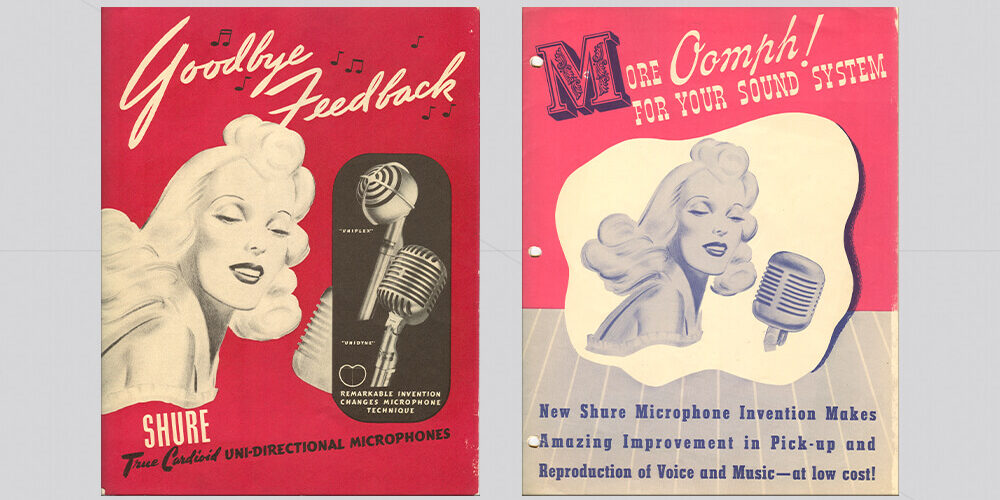
We recommend:
Shure SM58 Dynamic Cardioid Vocal Microphone
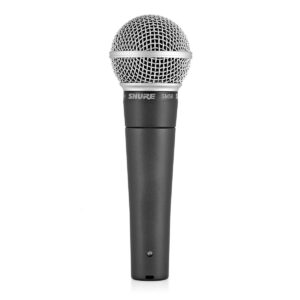 The Shure SM58 was released in 1966, following the SM57 in 1965. It was similar but boasted a few modifications.
The Shure SM58 was released in 1966, following the SM57 in 1965. It was similar but boasted a few modifications.
Designed primarily for vocals, the SM58 helped change the landscape of live music.
With its robust mic capsule and incredible ability to take gain without feeding back, the SM58 helped advance the size and power of live PA systems.
Unsurprisingly, the mic is beloved by figures like Henry Rollins, Frank Carter, Patti Smith, Public Enemy, and countless more.
It’s become the vocal mic for pretty much any genre of music due to its outstanding reliability and aggressive sound, and it is especially associated with rock and metal.
2. Sennheiser
Sennheiser are a German microphone manufacturer with post-war origins, founded in 1945 by Fritz Sennheiser just weeks after the end of World War II. The brand began producing unique noise-compensating microphones, with one of their earliest notable offerings being the DM4, as well as mixers, miniature headphones, geophysical equipment, and microphone transformers.
They broke the United States in the late 1950s and further rose to prominence when they began supplying airline Lufthansa with headsets.
Sennheiser’s versatility in production and components has allowed them to produce all kinds of dynamic and condenser microphones used live and in studios. They also produce headphones and now help push forward audio technology for streaming and advancing spatial audio with their AMBEO range and Dear Reality.
We recommend:
Sennheiser MD421 II Dynamic and Instrument Vocal Microphone
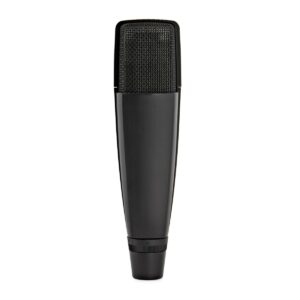 The Sennheiser MD421 II is a dynamic microphone that excels on both instruments and vocals.
The Sennheiser MD421 II is a dynamic microphone that excels on both instruments and vocals.
Most commonly used for tom drums and vocals, the MD421 can also be used on guitar cabs, bass amps, snare drums, hi-hats, and brass instruments.
The older models of the MD421 have been used as a vocal microphone by Paul McCartney, John Lennon, and Kevin Parker, whilst the newer version was used for guitar recording on Nirvana’s Nevermind and Queens of The Stone Age’s Lullabies to Paralyze.
Daft Punk even used it for tom drums on Random Access Memories, while Arctic Monkeys have used it as a live guitar cab mic.
3. Audio-Technica
Audio-Technica was founded in Tokyo in 1962 by Hideo Matsushita. The original intention of the company was to develop phonograph cartridges.
In 1969, Audio-Technica’s products gained enough steam to export their products worldwide, and they launched the world’s first microcassette recorders. By the 1980s, the advancement of digital audio formats like CDs was threatening Audio-Technica’s business model, and so they began developing a range of new products – including sushi machines, which they are still one of the biggest producers of to this day!
In 1972, Audio-Technica started creating microphones, resulting in the AT-800 series. However, it wasn’t until 1991 that they would really commit to this approach with the 40-Series studio microphones, opening with the AT4033.
The AT4050 followed in 1995, and the AT4060 tube microphone in 1998. Audio-Technica have now expanded far beyond the confines of Japan, with offices in America, the UK, and Singapore, and are well-known for not only turntables, but headphones, earphones, and microphones.
We recommend:
Audio-Technica AT2020 Cardioid Condenser Microphone
 The Audio-Technica AT2020 is an adaptable mic that suits a whole host of applications, from recording in home studios to broadcasting and streaming.
The Audio-Technica AT2020 is an adaptable mic that suits a whole host of applications, from recording in home studios to broadcasting and streaming.
With a maximum SPL handling of 144dB, it’s capable of capturing loud sound sources with ease, whether it’s drums, guitars, or vocals.
Using a custom-engineered 16mm low-mass diaphragm, the mic offers an extended frequency response of 20Hz – 20kHz and clear audio with a great transient response. Plus, it has ultra-low operating noise, giving you the best sound capture possible, with no interference.
The cardioid polar pattern further adds to the clear, focused audio. Thanks to the extra sensitivity at the front of the mic, and less at the sides and rear, any surrounding sound sources are rejected from the pickup – so you can capture only what you need.
Better still, the Audio-Technica AT2020 meets all your practical setup needs. It comes with a unique pivoting threaded stand mount that allows you to find the perfect positioning of the mic and soft protective pouch for safe transportation.
4. RODE
Rode were founded in Sydney, Australia beginning as an electronics store named Freedman Electronics. Husband and wife Henry and Astrid Freedman opened this store as a joint venture, selling third-party electronics. It offered loudspeakers, amplifiers, microphones, and mixing consoles, as well as some custom designs.
In 1990, with interest in home recording and music production kicking off, Henry and Astrid’s son, Peter, started modifying existing microphones to help develop his own design and test the market.
Seeing some success, Peter turned his tinkering into a full-blown business: Rode. The first design of Peter’s became the popular NT1. Steadily building popularity within both home and professional recording studios, Rode also managed to catch the fledgling content creation and videography market considerably early with the release of the VideoMic in 2004.
While younger than many of the other companies on this list, Rode’s commitment to adapting to the market’s needs and being ahead of the curve both technologically and in their design philosophy has driven their popularity.
We recommend:
Rode NT1 5th Gen XLR and USB-C Studio Microphone
 A modern revision of Rode’s first design, the Rode NT1 5th Gen is an affordable large diaphragm condenser that packs a lot of versatility and sound quality to rival many studio standards.
A modern revision of Rode’s first design, the Rode NT1 5th Gen is an affordable large diaphragm condenser that packs a lot of versatility and sound quality to rival many studio standards.
Commonly used for home recording, the NT1 can be used on many of the same sources you’d expect from a large diaphragm condenser: vocals, drums, acoustic guitar, guitar amps, and a variety of other instruments.
The NT1 5th Gen adds USB-C connectivity for easy, instant recording, and its USB output includes a 32-bit float recording option, which can help prevent clipping in recordings that would usually be distorted in 24-bit.
The popularity of the NT1 for vocals especially can’t be overstated, and it’s commonly used in pop, rap, and EDM.
While we don’t have solid information on who’s been using this latest version, its predecessor, the NT1-A has been used by EDM titans like Avicii, Nicky Romero, and Madeon, as well as rappers such as Juice WRLD, Future, and Mick Jenkins.
5. Neumann
Neumann were founded in Berlin in 1928 by Georg Neumann, an inventor and electronics engineer who developed record-cutting machines for phonographs, as well as rechargeable batteries.
Neumann’s first microphone was the CMV 3, also referred to as “The Bottle” for its distinctive shape. This was the first commercially available condenser microphone in the world, and it was commonly used around the time of World War II.
Neumann’s manufacturing was disrupted significantly by the war, with their factory in Berlin being heavily damaged during a bombing. So, production was shifted to a small town which then became occupied by Soviets, who seized the factory and ran the Neumann production line as a state-run operation under a different name.
Georg moved operations to Berlin, re-established the company independently, and began building a variant of the CMV 3 in 1949. This would become the instantly recognisable U47.
Neumann continued to produce a range of high-end microphones that became large parts of many famous albums – the M 49, M 50, U67, and U87 to name just a few. In modern years, Neumann have expanded to create binaural dummy heads, studio monitors, and even an audio interface!
We recommend:
Neumann U87 AI Studio Microphone
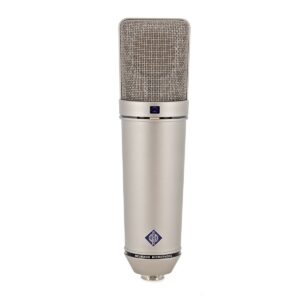 The Neumann U87 has to be one of the most instantly-recognisable studio microphones around, with many otherwise completely distinct large-diaphragm condensers even taking inspiration from the U87’s sleek look.
The Neumann U87 has to be one of the most instantly-recognisable studio microphones around, with many otherwise completely distinct large-diaphragm condensers even taking inspiration from the U87’s sleek look.
Released in 1967, the U87 was meant to replace the tube-based U67, making it one of Neumann’s earliest designs.
It’s widely seen as a vocal microphone, and whilst being one of the best picks around for vocals, it’s capable of so much more than that. Drum overheads, acoustic guitars, guitar amps, cellos, room ambience, spoken word, pianos, you name it, the U87 can capture it.
The U87 Ai has a slightly adjusted tuning and design from vintage editions but is still incredibly faithful to the original version.
It has been used by Tyler Joseph, Madeon, Hayley Williams, Ariana Grande, Jacob Collier, and Kanye West.
6. AKG
AKG are an Austrian microphone company that also came out of the fallout of World War II. Old friends Rudolf Görike and Ernst Pless reconnected in 1947 after the war, starting a small audio company in Vienna.
They originally started selling loudspeakers and modified film projectors to local movie theatres, before expanding into car horns, intercoms, and other consumer audio equipment.
Starting out with a small team of only seven, including Görike and Pless, the AKG team would hand-deliver these products on a bicycle. It wasn’t until 1949 that the company shifted their focus to what they became known for – headphones and microphones.
Among AKG’s most significant developments is the D12, the world’s first single-diaphragm cardioid dynamic microphone, which is now the standard design for dynamic mics. The C12 was a similarly popular tube microphone that’s been commonly used for all kinds of recordings.
Plus, the CK12 capsule had such a uniquely consistent directivity with changing polar patterns that it went on to be used on multiple microphones of the time, some not even developed by AKG!
We recommend:
AKG C414 XLS Condenser Microphone
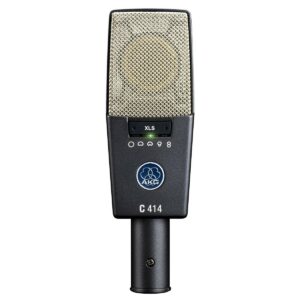 AKG’s CK12 capsule is a big part of what launched their popularity in the microphone space after the D12.
AKG’s CK12 capsule is a big part of what launched their popularity in the microphone space after the D12.
A condenser capsule with a neutral, accurate, and consistent sound signature, this capsule took extremely well to adaptation, modification, and changes in polar pattern without changing its sensitivity or frequency response.
To take full advantage of these strengths in the CK12, AKG developed the C414. First coming about in 1971, this large-diaphragm condenser quickly became a studio workhorse.
Commonly used on vocals, drums, guitar amps, and acoustic guitars, the natural, true-to-life sound of the C414 has found its way onto some legendary recordings.
Used on Smashing Pumpkins’ Oceania, Queens of The Stone Age’s Lullabies to Paralyze, and Nine Inch Nails’ The Downward Spiral, the C414 is suitable for just about any instrument.
This edition, the XLS, has a warmer vintage tone, whereas the XL II edition which is also available, is a more modern-sounding adaptation with extended treble.
7. Aston Microphones
Aston Microphones are another younger mic brand compared to many on this list. Starting in the UK, Aston drew from the heritage of British audio brands, taking inspiration from their characteristic sound.
Aston’s goal is to create unique microphones that can compete with the historical microphones that come in at way higher prices. They listen to feedback to inform their designs as they’re being worked on.
To this end, Aston have what they call the “Aston 33”, an initial group of 33 musicians, producers, and engineers who sit in blind listening tests to hear prototypes and how they compare to some of the most popular and commonly used microphones on the market. This allows them to give their thoughts on the design without any bias from knowing which product is which.
The Aston 33 has expanded to over 100 audio professionals, but still maintains the name as a nod to the original group who helped get the company off the ground.
We recommend:
Aston Microphones Spirit Multi-Position Condenser Microphone
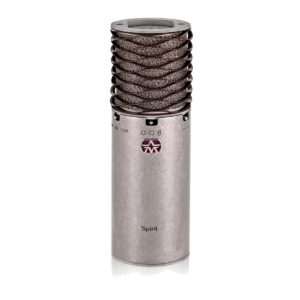 Aston’s current flagship, the Spirit, is another large-diaphragm condenser for instrument recording and vocals.
Aston’s current flagship, the Spirit, is another large-diaphragm condenser for instrument recording and vocals.
Built to compete with some of the most iconic microphones in the world for a fraction of the price, the Spirit takes the smooth sound of the Origin and iterates upon it.
There’s adjusted tuning, different polar patterns, multi-position pads, and a transformer to enhance the details of its sounds.
The Spirit is well-suited as a centrepiece microphone for project studios, working well on vocals, drum overheads, drum room, guitars, percussion, and even orchestral recording.
It has been used by producers Chris Porter, Dave Pemberton, and John Cornfield, as well as musicians like Simple Minds’ Ged Grimes.
8. Universal Audio
Universal Audio are an American company founded in 1958 by Bill Putnam Sr., a recording engineer well-known for his work with Frank Sinatra, Nat King Cole, and Ray Charles, among others.
A true innovator, it’s arguable that, alongside Les Paul, Putnam Sr. is a key figure in modern recording technology. He helped develop stereophonic recording, invented the concept of vocal booths and multi-band EQ, and helped revolutionise recording console design. Putnam founded three companies in his career: Universal Audio, Studio Electronics, and UREI.
These companies developed and produced the 610 tube-based recording console, LA-2A compressor, and 1176 compressor, as well as a great deal of other ubiquitous pieces of studio gear. Universal Audio was re-established by Putnam Sr.’s children, Bill and Jim Putnam, resolving to reissue and innovate the hardware their father was renowned for, as well as adapt the dawn of the digital age.
From here, Universal Audio became known for not only their legendary compressors and preamps, but also their plugins, audio interfaces, and now even a DAW. But they have also applied their knowledge to microphones.
We recommend:
Universal Audio Sphere DLX Modeling Microphone
The Universal Audio Sphere DLX is a large-diaphragm condenser with a wholly flat, neutral response.
Unlike a typical condenser microphone, its sound isn’t what’s important about it. The important part comes afterwards, where you can use the Universal Audio plugins to apply room correction, attenuation, and modelling of up to 38 classic studio microphones to achieve your dream sound.
The DLX features two capsules, one on either side, that let you carry out stereo recording too, so it can even be used for a stereo drum overhead, or adding width to your room mics!
The Sphere DLX has been used in the studio by Dave Grohl and Gunna.
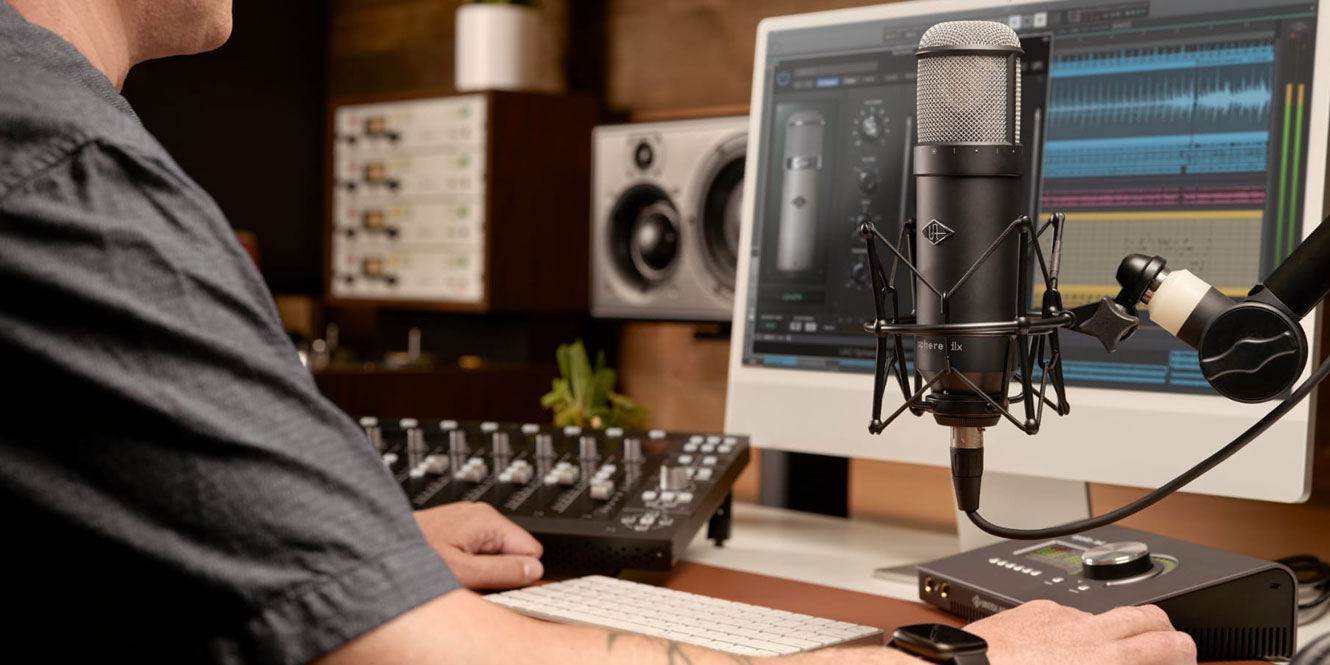
9. SubZero
As well as PA systems, guitars, and all-valve amplifiers, SubZero offer a range of professional-quality microphones. The brand is a go-to for musicians, public speakers, or people putting on an event who want premium standard equipment that delivers clear and crisp sound, without forking out a fortune.
SubZero microphones vary from dynamic to condenser, USB to ribbon, and more, and they’re all built with an extremely durable yet aesthetically pleasing metal chassis to protect them against wear and tear. Each mic, though, is slightly different and has been built with great attention to detail.
The SubZero R1 Ribbon mic, for example, stays true to the classic 1950s British and German ribbon microphones it’s inspired by, offering the same natural and musical sound. The SZC-300 Condenser, on the other hand, is built for people who need versatility, a quick record-ready setup, and detailed sound courtesy of the 30Hz-20kHz response.
We recommend:
SubZero SZM-11 Dynamic Vocal Microphone
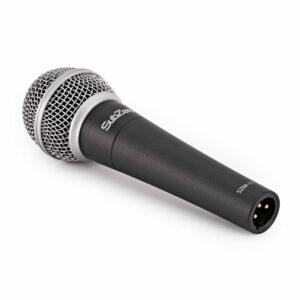 The SubZero SZM-11 Dynamic Vocal Mic is designed for stage and studio, offering a cardioid polar pattern and great off-axis rejection – so it picks up your voice – and your voice only – in incredible detail.
The SubZero SZM-11 Dynamic Vocal Mic is designed for stage and studio, offering a cardioid polar pattern and great off-axis rejection – so it picks up your voice – and your voice only – in incredible detail.
Whatever your genre, the versatility of this microphone ensures it delivers with any style, from rock to pop or jazz to rap and everything in between.
Better still, the SZM-11 has been carefully designed with a small increase in the mid-frequency range. This allows you to really cut through the mix.
Like all SubZero mics, this one features a rugged construction that can withstand a lifetime of use.
And thanks to a protective foam insert, the mic doesn’t require a pop filer or windshield – it’s ready straight out of the box!
10. Lewitt
Lewitt are an Austrian microphone manufacturer with a modern heritage backing up an innovative design philosophy. Founded in 2009 by Roman Perschon after some work in larger companies, Perschon wanted to create some new, unique designs and forge the future of microphones instead of focusing on vintage designs of the past.
Lewitt have released a range of notable and fresh microphone designs since their inception, catching attention with their affordable, fresh sound. Using high tolerance for component matching, low noise, and new electronic components to build their products, Lewitt are helping to change modern recording.
We recommend:
Lewitt RAY Microphone
 The Lewitt RAY microphone is a great option for content creators.
The Lewitt RAY microphone is a great option for content creators.
It’s packed with innovative features, one of which is the ‘Mute by Distance’ function, which automatically mutes or unmutes the mic as you move in and out of a preset range. This makes it perfect for live streams, video conferences, or performances where you need hands-free control.
Additionally, the RAY features a unique built-in mute button, providing quick and silent muting right at your fingertips.
Designed with a 1-inch true condenser capsule and AURA technology, the RAY ensures clear, exceptionally polished audio. And thanks to its cardioid polar pattern, the mic focuses purely on the sound source in front of it.
Better still, the RAY delivers high-quality sound without needing extensive setup or post-processing, so you can start recording straight away. It comes equipped with useful accessories, including a magnetic pop filter, windscreen, shock mount, and cushioned mic bag, ensuring you have everything you need for a seamless setup.
11. sE Electronics
sE Electronics were founded in 2000 by Siwei Zou, a conductor, composer, and bassoon player who began building his own condenser microphones after visiting California on a scholarship during his studies. When he returned home to Shanghai, he founded sE Electronics. Their first microphone, the sE 2000, was released in 2002 and stayed in production for a decade.
Priding themselves on being family-owned, Siwei handed over the general operations of the company to his daughter Ling in 2008, while keeping himself busy by delivering guest lectures and other musical projects.
sE are best known for their microphones – which see both live and in studios – but have also dabbled in studio monitoring systems. They have even collaborated with audio design legend Rupert Neve on a range of premium mics.
We recommend:
sE Electronics sE2200 Large-Diaphragm Condenser Microphone
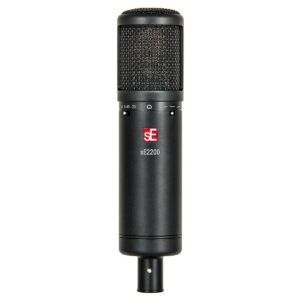 The sE Electronics sE2200 is a modernised version of sE Electronics’ first release, the sE 2000.
The sE Electronics sE2200 is a modernised version of sE Electronics’ first release, the sE 2000.
It’s a large-diaphragm condenser that is built to be an affordable studio workhorse for project studios and professional recording alike.
The 2200’s handmade capsule, discrete components, and custom transformer give it a warm, vintage-inspired sound with additional detail. sE also offer a version of the 2200 with multiple polar patterns, the sE2300.
The sE 2200 does extremely well on vocals, which seems to be where it’s often found, however, it can handle acoustic guitars, drum overheads, guitar amps, brass, room mic duties, and everything else you’d expect from a workhorse condenser.
This condenser microphone has been used to record Amy Winehouse and You Me At Six, and it’s used by engineers and producers like John Browne and Martin Furia.
12. DPA Microphones
DPA Microphones are a Danish company, founded in 1992 after electronics company Brüel and Kjaer closed their Pro Audio department to shift their focus to other products. This predecessor to DPA built extremely linear, accurate reference microphones that helped to define the sound that DPA would aim for with their future products.
DPA released their first offering, the 4006, utilising the same fully linear response seen in the reference microphones they used to build. This made it an engineer’s choice, since it produced a flat, uncoloured sound that they could later shape in the mix to fit the result they wanted.
The brand has won awards for many of their designs, and they’ve even been used to capture the takeoff of the Apollo 13, sounds on Mars, and snowflakes falling in Antarctica!
We recommend:
DPA 2028 Supercardioid Vocal Microphone
 The DPA 2028 Supercardioid Vocal Microphone is crafted to deliver pristine, transparent vocal performance, making it great for live stages.
The DPA 2028 Supercardioid Vocal Microphone is crafted to deliver pristine, transparent vocal performance, making it great for live stages.
With a new high-performance capsule, the mic is designed to capture the authentic tone of your voice without colouration or distortion. This ensures that soft, delicate notes and powerful, dynamic sounds are both conveyed with clarity and natural presence.
The 2028’s supercardioid polar pattern provides excellent gain-before-feedback, so you can focus on your performance without worrying about unwanted noise or feedback issues.
There’s also DPA’s flat off-axis response that helps maintain a consistent sound quality, even in not-ideal acoustic environments This minimises bleed from other instruments and ensures that your vocals remain clear and true-to-life.
With a robust, high-quality construction, the 2028 can withstand the demands of live performance, from intimate venues to large festival stages. And for effective handling of noise and plosive sounds, the mic comes with a specially designed shock mount and pop filter.
13. Electro-Voice
Electro-Voice are an American electronics manufacturer founded by Lou Burroughs and Albert R. Kahn. Burroughs and Kahn initially worked at a company called Radio Engineers, servicing radio receivers in the basement of a car tyre company in Indiana.
As a result of the Great Depression, the two engineers switched focus to audio products. They built a PA system for a university football coach, Knute Rockne, who had health issues that affected his ability to project his voice. He was overjoyed with the system, calling it his “electric voice”. This inspired the re-founding of the company under the new name it would carry for the next 93 years.
World War II was a chance for Electro-Voice to expand technology, developing the noise-cancelling microphone to help make communications from pilots, tank crews, ship crews, and ground troops clear and understandable. This was the T45. Electro-Voice patented this technology but provided it freely and openly so other manufacturers could develop mics with this design to help the war effort.
Electro-Voice are probably best known nowadays for their dynamic microphones especially as well as their PA systems and portable speakers.
We recommend:
Electro-Voice RE20 Dynamic Cardioid Microphone
 The Electro-Voice RE20 is a veritable icon of dynamic microphones. A standard bearer of the coveted “classic broadcast sound”, the RE20 has a flat midrange with warm bass and a crisp presence boost. This has made the RE20 a top choice for radio, broadcast, and voiceover work ever since its release in 1968.
The Electro-Voice RE20 is a veritable icon of dynamic microphones. A standard bearer of the coveted “classic broadcast sound”, the RE20 has a flat midrange with warm bass and a crisp presence boost. This has made the RE20 a top choice for radio, broadcast, and voiceover work ever since its release in 1968.
Using what Electro-Voice called “Variable D” technology, which they developed in 1953, off-axis colouration was prevented, giving it a consistent pickup of whatever was placed in front of it and reducing proximity effect.
Whilst commonly used for singing and spoken vocals, both in broadcast and live performance, the RE20 has also seen a lot of studio use as an instrument mic. Snare drums, toms, brass, woodwinds, kick drums, acoustic guitar, amps, and cabinets for both electric guitar and bass all do extremely well with the RE20.
Podcasters, engineers, and musicians alike swear by this dynamic microphone. It has been used by Stevie Wonder, Joan Jett, Carlos Santana, Kurt Cobain, Thom Yorke, and Kendrick Lamar.
14. beyerdynamic
beyerdynamic was founded by Eugen Beyer in Berlin, in 1924. Much like AKG, beyerdynamic started out producing speakers for film theatres. Their first set of headphones – the DT 48 – followed at the end of the 1930s.
Unlike many other audio manufacturers of the time who saw a period of prosperity and innovation throughout World War II, beyerdynamic had to temporarily freeze production, before returning in 1948, with a new factory in Heilbronn.
The first of beyerdynamic’s microphones were ribbon microphones, the M 160, and the M 130, both launched in 1957. They have become extremely popular studio microphones and still see use in studios and are produced even now. Other beyerdynamic products, their E-1000 microphones and sound transformers have seen used by The Beatles, Elton John, ABBA, and Stevie Wonder.
We recommend:
beyerdynamic M 160 Double Ribbon Microphone
 The M 160 was beyerdynamic’s first microphone design. The fact that it’s still in production since its release in 1957 speaks volumes about its quality.
The M 160 was beyerdynamic’s first microphone design. The fact that it’s still in production since its release in 1957 speaks volumes about its quality.
A hypercardioid ribbon microphone with the warm, smooth sound you’d expect from a ribbon element, this mic would seem to smooth out harsher signals, making it especially beloved on distorted guitar amps.
Whilst it found a lot of use on drum overheads and guitars, it shines on most instruments, with a unique double-ribbon design giving it more detail and treble than many other ribbon mics of the time.
The M 160 has recorded Jimi Hendrix, Steve Vai, and Mick Thomson’s searing guitars, as well as being room mics for John Bonham’s thunderous drums on “When The Levee Breaks”.
15. Austrian Audio
Austrian Audio are a recent manufacturer in the industry, but they boast a rich history of excellence to back them up. Built from a core of 22 former AKG employees, Austrian Audio were incorporated in 2017 in the wake of AKG shifting their production hub from Austria to the United States.
Immediately, the company got to work on forging a new identity while using the lessons they’ve learned from their tenure in AKG to build great, forward-thinking microphones.
AKG are famous for their old condenser capsule designs, and Austrian Audio haven’t strayed from this tradition. With their very own CKR12 ceramic capsule present in their flagship models, Austrian Audio offer quality headphones as well as dynamic and condenser microphones for live and studio recording.
We recommend:
Austrian Audio OC18 Condenser Microphone
 Hand-built in Vienna, the Austrian Audio OC18 Condenser Microphone is ideal for songwriters, producers, and engineers. This large-diaphragm condenser features a cardioid polar pattern that ensures focused audio capture with minimal off-axis sound interference.
Hand-built in Vienna, the Austrian Audio OC18 Condenser Microphone is ideal for songwriters, producers, and engineers. This large-diaphragm condenser features a cardioid polar pattern that ensures focused audio capture with minimal off-axis sound interference.
It’s also designed to optimise your recordings before they reach the preamp. The mic includes -10dB and -20dB attenuation pads, allowing you to manage high sound pressure levels (SPL) without distortion, ideal for capturing drums or amplifiers.
A three-position high-pass filter then helps control low-frequency rumble, adding further flexibility in different recording scenarios.
Central to the OC18’s exceptional sound quality is its CKR12 ceramic capsule, shared with the flagship OC818 model. It ensures detailed, clear audio, whilst Austrian Audio’s Open Acoustics Technology enhances the overall performance.
The microphone set includes a spider shock mount, windshield, and clip, all neatly stored in a durable carry case.
16. Audix
Audix are an American microphone manufacturer founded by Cliff Castle in 1984. Setting out to push the limits of technology, Audix’s microphones are researched, designed, and assembled in Oregon.
Castle met Fred Bigeh in San Francisco in 1981, and the two experimented with business ideas and products until the concept of Audix began to crystallise, with Castle handling the business whilst Bigeh managed the technical designs.
Facing initial scepticism from the audio industry, Audix struggled to get their products stocked by retailers but managed to release their first design, the OM1, in 1986. The scepticism quickly faded after the OM1 came onto the scene, becoming a choice of many industry professionals.
Audix’s reputation was quickly cemented from there, and they became known for forward-thinking designs at great prices for both live and studio work.
We recommend:
Audix OM7 Premium Dynamic Vocal Microphone
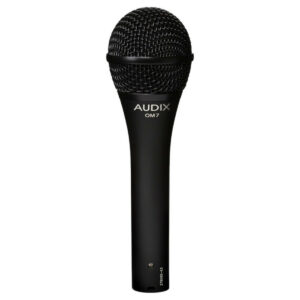 The OM7 is one of Audix’s most recognisable and iconic mics.
The OM7 is one of Audix’s most recognisable and iconic mics.
A handheld dynamic microphone built for vocals, the OM7 was a part of Audix’s first range of products – the OM Series, with this particular model being released in 1991.
The OM7 can take huge gain levels before causing feedback and resists the proximity effect often caused by performers cupping the microphone, making it a great choice for rowdier genres like rock, punk, and metal especially.
Its high headroom, wide dynamic range, and full frequency response with a focused hypercardioid polar pattern make this a great choice for live performance.
The OM7 has been used by Kurt Cobain, John Frusciante, Tom DeLonge, Kevin Shields, and Eddie Vedder, who was seen using it on the cover of Time Magazine!
Which microphone brand is best for you?
There are many things that can dictate what you might look for in a microphone. Think of where and how you want to use it, what you want to use it on, and how much you’re able to spend. For example, a Shure SM58 is a great choice for live vocal performances, but you’ll often want a large-diaphragm condenser for the studio instead, for extra detail and clarity.
However, using an AKG C414 for high-pressure sources like live vocals or low-frequency sounds like kick drums probably isn’t going to yield the results you want.
Shure make some great robust microphones for live sound use that are also great for home recording. Meanwhile, Neumann microphones are sensitive, detailed, and expensive, so shouldn’t be used on-stage.
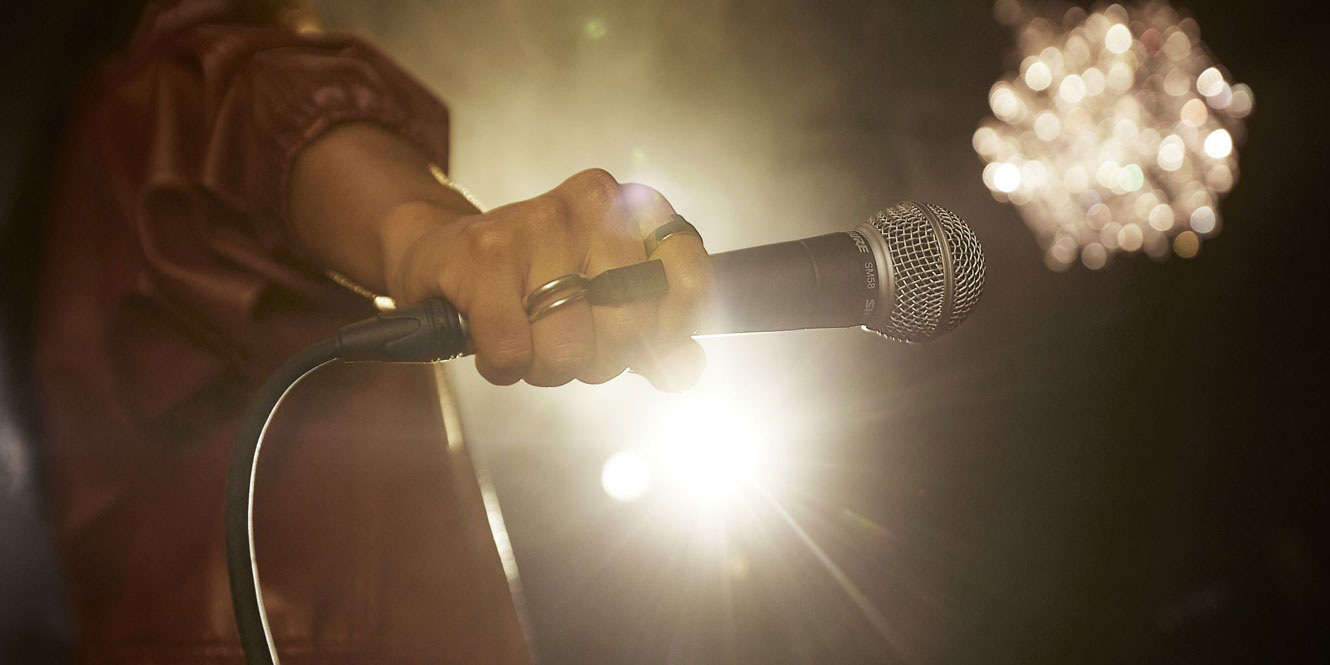
FAQs
Which brand of mic is best?
Here are our picks for the top 5 microphone brands:
- Rode
- beyerdynamic
- SubZero
- Shure
- Sennheiser
How much should a good mic cost?
Most good mics for live and home studio use tend to lie between £100 and £500 for both dynamics and condensers. Dynamic mics tend to be cheaper, while condensers are more expensive. Premium studio microphones can cost anything between £1000 and £7000.
Are expensive mics better?
Expensive mics aren’t necessarily always better. You definitely get what you pay for with microphones in terms of build quality, sound quality, and features. However, context is key with microphones, and you don’t always have to spend a lot to get the right mic for the job. Certain sources may not warrant the risk of damage to an expensive mic, or placement on the source may prove more difficult, or there’s a chance of more premium mics being stolen from live venues or damaged on tour, for example.
Final thoughts
So, what have we learned? There’s a range of excellent microphone manufacturers all over the world, with different focuses, intents, and sound characteristics that you might want to consider. And it’s probably a pretty safe bet to go with a microphone brand if they came about before World War II and are still going today!
At the end of the day, only you know what mics are right for you. Maybe you want the punchy midrange-focused sound of Shure to cut through your PA system or the silky detail of a classic Neumann mic to help your song sound almost mixed while tracking in the studio.
Whatever the case, there’s a brand that makes at least one or possibly a few mics that are right for you, and it’s impossible to go wrong with the ones we’ve nodded to here, which is why these are our picks for the best microphone brands.
Want more brands? But this time, for headphones? Check out our guide to the 13 best headphone brands.














0 Comments